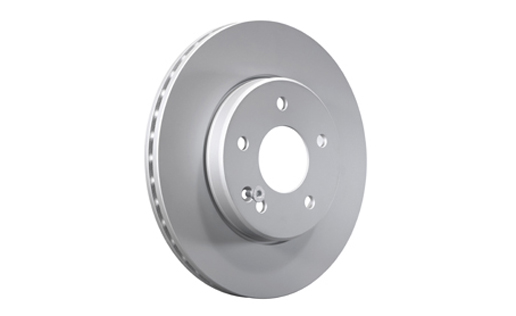Brake disc
The brake disc is an important component of the brake system. If the brake system is to be able to decelerate the vehicle in safety and comfort at all times – bringing it to a complete stop if necessary – the brake disc must...
Function

The brake disc is an important component of the brake system. If the brake system is to be able to decelerate the vehicle in safety and comfort at all times – bringing it to a complete stop if necessary – the brake disc must combine with the brake pads to generate a brake torque (a brake force). This torque is transmitted to the wheel hub and from there to the wheel rim. During braking, the vehicle's kinetic energy is converted into thermal energy due to friction between the brake pads and the brake disc, thereby enabling a reduction in speed to be achieved.
90% of the heat generated during braking penetrates the brake disc initially, where it is buffered. After this it is passed on to the ambient air. The brake disc thus functions like a heat exchanger. However, its ability to absorb heat is limited. Therefore, the heat must be dissipated to the ambient air quickly if damage due to overheating is to be avoided.
Types of brake dics
During downhill driving, the friction ring can reach temperatures of up to 700°C (red heat). Ventilated brake For this reason, ventilated brake discs are very often used for better cooling – primarily at the front axle. Their surface area is much larger and better suited for heat exchange. Compared with ventilated brake discs, solid brake discs can only dissipate heat to the environment more slowly. The friction rings on ventilated brake discs are interconnected by means of webs in the shape of ribs or domes. The rotation of the brake disc generates air suction which draws air out from the inside of the brake disc through a ventilating duct. The tiny particles of air that this causes to come into contact with the surface of the brake disc absorb the thermal energy and transport it outwards. Perforated or grooved brake discs Even more effective cooling can be achieved with perforated or grooved brake discs. These types of disc also benefit from being less sensitive to wet. However, they are more expensive and can in some circumstances generate much more noise during braking.
Noise generation and vibrations during braking
Friction rings on brake discs generally have a tendency to deform when heated up. This can lead to unpleasant noise generation and vibrations during braking (brake judder). It is for this reason that well-known brake manufacturers are striving to find ways of adapting the design of brake discs in order to prevent deformation. However, in some cases, brake judder is unavoidable, as vibrations or play in wheel bearings can bring brake pads into repeated contact with the brake disc even when no active braking is taking place. The resulting localised flatting of the brake disc, which after a certain period of time will lead to pulsating braking, then becomes apparent to the driver in the form of judder.
Brake disc material
Brake disc material must meet strict requirements. It must be able to withstand
- mechanical stress applied as a result of pressure and tensile forces during braking,
- centrifugal forces at high wheel speeds and
- thermal loads.
- high dimensional stability in all temperature ranges,
- low own weight, good brake response,
- extremely long service life and
- very good fading characteristics.
Origin of brake disc
The disc brake was originally developed for motor sport. Having enjoyed considerable success in that field, it rapidly established itself in the front wheels of passenger cars in the 1960s.
The drum brake that had been used prior to this time had numerous weak points brought about by its design, including temperature problems, distortion and fading, oscillating friction values, poor dosing, high wear and noise generation (squealing). For many years after this, the disc brake was only seen very rarely at the rear wheels, where thermal load is lower.
Depreciation
Brake discs are exposed to very high mechanical and thermal loads. Added to these are environmental factors such as spray water, road grime and spreading material. They are therefore subject to natural wear. The condition of the brake discs is checked during every vehicle inspection. If the wear limit has been reached, they must be replaced in order to safeguard the reliable functioning of the brake system.

Many manufacturers have started to offer coated brake discs for brake repairs. Brake discs of this type are coated with a special paint which protects the brake discs (not the friction surface) against corrosion. As they retain their attractive appearance over time, coated brake discs are a good choice for open wheel rims.

















